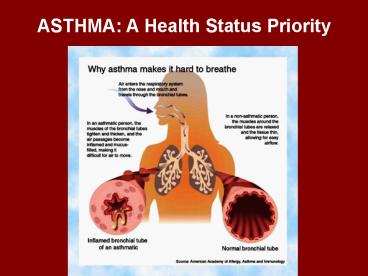ASTHMA: A Health Status Priority - PowerPoint PPT Presentation
1 / 30
Title:
ASTHMA: A Health Status Priority
Description:
Asthma is a chronic inflammatory disease characterized by wheezing, coughing, ... that cause an allergic response) or irritants (substances that irritate ... – PowerPoint PPT presentation
Number of Views:215
Avg rating:3.0/5.0
Title: ASTHMA: A Health Status Priority
1
ASTHMA A Health Status Priority
2
Asthma is a chronic inflammatory disease
characterized by wheezing, coughing,
breathlessness and chest tightness resulting from
the constriction of the airways.
Asthma symptoms can be triggered by allergens
(substances that cause an allergic response) or
irritants (substances that irritate the nose or
airways, provoking asthma symptoms), such as
animal dander, air pollution, dust mites, pollen,
mold, ETS, or stress.
3
The purpose of coming up with Health Status
Priorities
- Identify health outcomes . . .
- that represent core areas of the Division . . .
- which are measurable and . . .
- can be improved.
4
Why Asthma?
- Asthma is a pervasive environmentally related
disease.
- Approximately 121,400 adults and 51,000 children
in New Mexico have asthma.
- Approximately 35 of cases are directly related
to man-made outdoor air pollution and most of the
rest is the result of the indoor environment or
natural outdoor allergens.
2. Capacity and funding.
- Surveillance data collected since 2000.
- Important to two CDC grants (Asthma and Tracking).
- The Asthma Program funds interventions to reduce
the disease burden.
5
- The Asthma Program Funds
- Educational outreach.
- Provider training.
- Indoor air quality assessment
- for schools.
- More specifically . . .
- Asthma Allies Rural Tour provider training and
patient education. - Tools for School indoor air quality assessment.
- Region 2 CMS Asthma Clinics.
- Passage of Senate Bill 275 that allows students
to self-administer asthma medications. - Childcare Asthma Manual to educate thousands of
registered childcare providers.
6
(No Transcript)
7
Which Asthma Indicator to use?
- Asthma Prevalence
- Asthma Deaths
- Asthma Emergency Department Admissions
- Asthma Hospital Inpatient Discharges
8
ASTHMA PREVALENCE
9
(No Transcript)
10
(No Transcript)
11
Asthma Prevalence?
- We dont really know what causes asthma.
- We dont know how to prevent it.
- We dont know why its increasing.
THEORIES . . .
- Persistent exposure to asthma triggers by
genetically predisposed individuals. - Immunological over-activation of t-cells (TH1
or TH2) caused by - exposure to parasites
- exposure/non-exposure to bacteria
- exposure to psychological/social stress
- obesity and inactivity
- . . . in genetically predisposed individuals.
12
ASTHMA DEATHS
13
Rates derived from ICD-9 codes, NM and US data
from CDC Wonder. Rates derived from ICD-9
codes, NM data from BVRHS US data from CDC
Wonder. Rates derived from ICD-10 codes, NM
data from BVRHS US data from CDC Wonder. NOTE
Comparability ratios have been applied.
14
Asthma Deaths?
- Relatively few people die of asthma.
- Most are older individuals who have other
chronic conditions. - Death rate is on the decline already.
15
EMERGENCY DEPARTMENT DATA
NOTE Data represent New Mexico residents who
were admitted to non-federal emergency rooms
within the state. Data were collected from every
hospital emergency department in the state.
16
NOTE Data represent New Mexico residents who
were admitted to non-federal emergency rooms
within the state. Data were collected from every
hospital emergency department in the state.
17
All Ages
18
Age lt15
19
Emergency Department Data?
- Data collection is quite onerous.
- No single data steward (39 separate requests).
- Involves costly data abstracting to get data.
- Lengthy process (numerous phone calls, emails,
letters). - In part, rates reflect access to care issues.
20
Asthma ICD-9 Diagnoses Codes
- 493.0 493.92
- The following fifth-digit subclassification is
for - use with category 493.0-493.2, 493.9
- 0 unspecified
- 1 with status asthmaticus
- 2 with (acute) exacerbation
- 493.0 Extrinsic asthma
- Allergic Asthma with stated cause (atopic,
childhood, hay fever with asthma) - 493.1 Intrinsic asthma
- Late-onset asthma
- 493.2 Chronic obstructive asthma
- Asthma with chronic obstructive pulmonary disease
COPD or - Chronic asthmatic bronchitis
- 493.8 Other forms of asthma
- Bronchial Asthma, allergic NOS, Allergic
Bronchitis or Asthmatic Bronchitis.
21
ASTHMA HOSPITALIZATIONS
SOURCE NMHPC. (American Indians are excluded).
22
(No Transcript)
23
(No Transcript)
24
(No Transcript)
25
(No Transcript)
26
(No Transcript)
27
(American Indians are excluded).
28
We have chosen Primary Asthma Hospital Inpatient
Discharges, Ages lt15, as our Health Status
Priority measure.
- Single data steward and the data are easy to
obtain (HPC). - HID rates are easier to impact.
- One age group is most affected.
- One region has significantly higher rates.
- Only non-federal in-state hospitals.
- Along with Injury Bureau, we are purchasing
Texas HID. - HPC has plans to obtain out-of-state NM data in
the future. - We hope to get comparable I.H.S. data.
29
EHEB would like to think all those who
participated in the Health Status Priority
meeting for Environmental Health.
An email requesting times for the next EH HSP
Meeting will be sent out in the near future.
30
(No Transcript)































